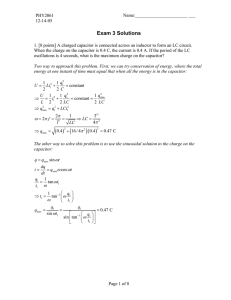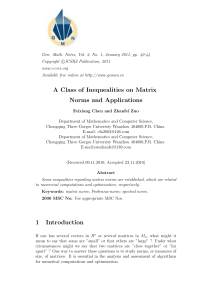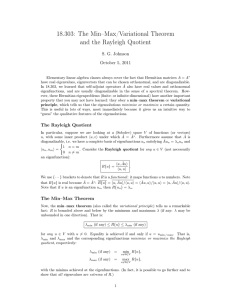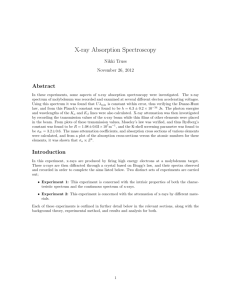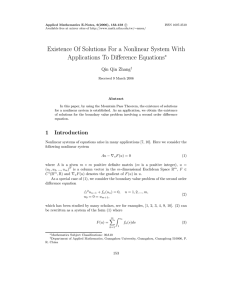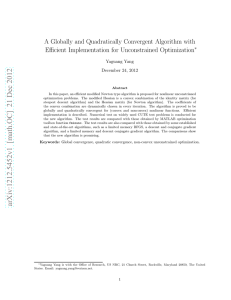Supplementary Document for: Health Aware Planning Under Uncertainty for Collaborating Heterogeneous Teams of
advertisement
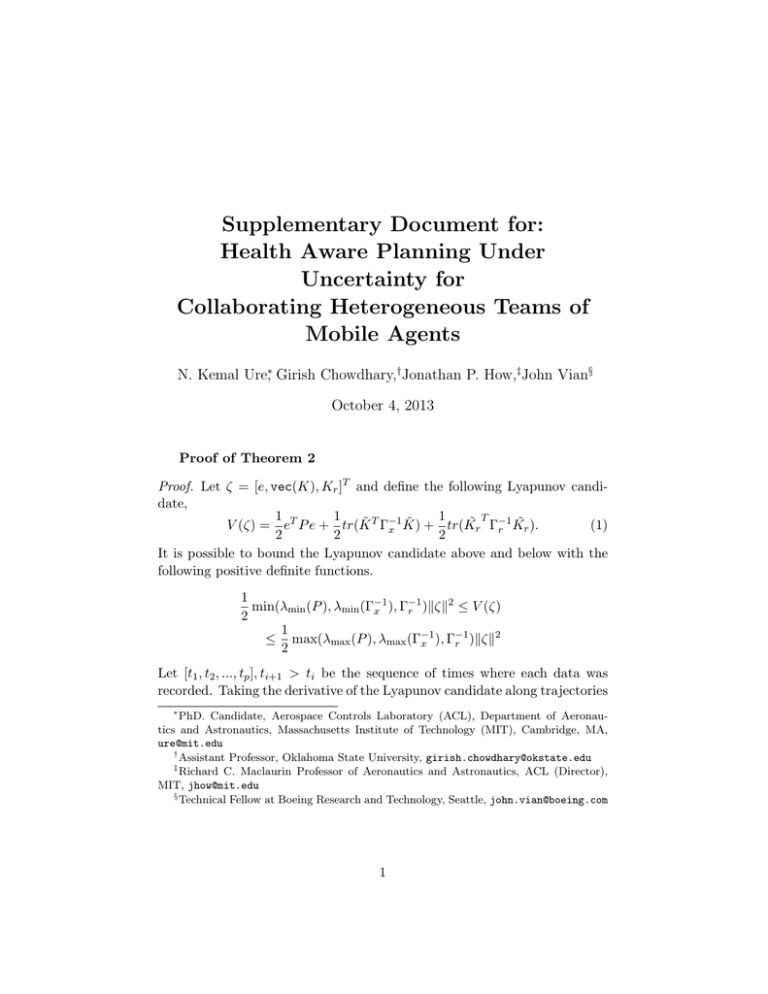
Supplementary Document for: Health Aware Planning Under Uncertainty for Collaborating Heterogeneous Teams of Mobile Agents N. Kemal Ure∗, Girish Chowdhary,†Jonathan P. How,‡John Vian§ October 4, 2013 Proof of Theorem 2 Proof. Let ζ = [e, vec(K), Kr ]T and define the following Lyapunov candidate, 1 1 1 T −1 (1) V (ζ) = eT P e + tr(K̃ T Γ−1 x K̃) + tr(K̃r Γr K̃r ). 2 2 2 It is possible to bound the Lyapunov candidate above and below with the following positive definite functions. 1 −1 2 min(λmin (P ), λmin (Γ−1 x ), Γr )kζk ≤ V (ζ) 2 1 −1 2 ≤ max(λmax (P ), λmax (Γ−1 x ), Γr )kζk 2 Let [t1 , t2 , ..., tp ], ti+1 > ti be the sequence of times where each data was recorded. Taking the derivative of the Lyapunov candidate along trajectories ∗ PhD. Candidate, Aerospace Controls Laboratory (ACL), Department of Aeronautics and Astronautics, Massachusetts Institute of Technology (MIT), Cambridge, MA, ure@mit.edu † Assistant Professor, Oklahoma State University, girish.chowdhary@okstate.edu ‡ Richard C. Maclaurin Professor of Aeronautics and Astronautics, ACL (Director), MIT, jhow@mit.edu § Technical Fellow at Boeing Research and Technology, Seattle, john.vian@boeing.com 1 of the system for each interval [ti , ti+1 ] and performing simplifications, we get: 1 T V̇ (ζ) = − eT Qe + (K̃ T xeT + K̃r reT )P (B − B̂) 2 p p X T X T T −tr(K̃ xj ˆKj ) − tr(K̃r rj ˆTKr ) j=1 j=1 Define, ˜ = ˆ − , B̃ = B̂ − B, 1 T V̇ (ζ) = − eT Qe − (K̃ T xeT + K̃r reT )P B̃ 2 p p X T X T T T T −tr(K̃ xj xj K̃ ) − tr(K̃r rj rjT K̃r ) j=1 −tr(K̃ T j=1 p X xj ˜TKj ) − tr(K̃r j=1 T p X rj ˜TKr ). j=1 P Note that the matrix Ω = pj=1 xj xTj is positive definite. Bounding the inequality above using norms and the triangle inequality, 1 1 V̇ (ζ) ≤ − λmin (Q)kek2 − λmin (Ω)kK̃k2 2 2 p X 1 − ( rj2 )kK̃r k2 + kK̃kkxrm kkekkP kkB̃k 2 (2) j=1 +kK̃kkek2 kP kkB̃k + kK̃r kkrkkekkP kkB̃k p p X X +kK̃kkP kk xj ˜K k + kK̃r kkP kk rj ˜Kr k j=1 j=1 Note that as long as the matrix Ω is full ranked (which can be guaranteed if the reference signal r is exciting over a finite interval [0, T ] [1]) and sgn(B) = sgn(B̂), the first three terms on the right hand side of the inequality above are negative-definite. Conservative bounds on the rest of the right hand side terms can be found as follows: The matrix Arm of the reference model is assumed to be Hurwitz and the reference signal r is always bounded, therefore there exist scalars cr , cxrm > 0 such that kxrm k < crm , krk < cr . Note that kB̃k is assumed to be bounded, therefore there exists a scalar cB such that kP kkB̃k < cB . Finally, note that the error terms ˆ are functions of recorded data xj , rj , which are bounded by assumption and do 2 not evolve P there exist scalars cx , cr > 0 such that P with time. Therefore kP kk pj=1 xj ˜K k < cx , kP kk pj=1 rj ˜Kr k < cr . Hence, 1 1 V̇ (ζ) ≤ − λmin (Q)kek2 − λmin (Ω)kK̃k2 2 2 p X 1 − ( rj2 )kK̃r k2 + crm cB kK̃kkek + cB kK̃kkek2 2 (3) j=1 +cr cB kK̃r kkek + cx kK̃k + cr kK̃r k. P Therefore, for sufficiently large λmin (Q), λmin (Ω), and pj=1 rj2 , V̇ (ζ) ≤ 0 outside of a compact set. To see that the set is indeed compact, note that the terms on the right hand side of Eq. 3 yield three quadratic inequalities in kek, kK̃k and kK̃r k. A conservative estimate of the positively invariant set within which the solutions are bounded can be found by solving these quadratic inequalities for each variable while assuming that other two variables are non-zero. First we check the case where kK̃k > 0, kK̃r k > 0. In this case, kek ≥ −be + p b2e − 4ae ce 2ae (4) 1 ae = − λmin (Q) + cb kK̃k 2 be = crm cB kK̃k + cr cB kK̃r k p 1 1 X 2 2 ce = − λmin (Ω)kK̃k − ( rj )kK̃r k2 2 2 j=1 +cx kK̃k + cr kK̃r k then V̇ (ζ) ≤ 0. Secondly, we consider the case kek ≥ 0, kK̃r k ≥ 0. In this case, V̇ (ζ) ≤ 0 if q −bk + b2k − 4ak ck (5) kK̃k ≥ 2ak 1 ak = − λmin (Ω), 2 bk = crm cB kek + cB kek2 + cx p 1 X 2 1 ck = − λmin (Q)kek2 − ( rj )kK̃r k2 2 2 j=1 +cr cB kK̃r kkek + cr kK̃r k 3 (6) Then we check the case where kek ≥ 0, kK̃k ≥ 0. kK̃r k ≥ −bkr + q b2kr − 4akr ckr 2akr (7) p akr 1 X 2 = − ( rj ), 2 j=1 bkr ckr = cr cB kek + cr 1 1 = − λmin (Q)kek2 − λmin (Ω)kK̃k2 2 2 crm cB kK̃kkek + cB kK̃kkek2 + cx kK̃k. (8) Inequalities 4–7 characterize the compact set outside of which V̇ (ζ) ≤ 0. Therefore, all solutions will eventually end up within this set, which in turn proves that the system [e, K̃, K̃r ] is uniformly ultimately bounded. References [1] G. Chowdhary, T. Yucelen, M. Mühlegg, and E. N. Johnson, “Concurrent learning adaptive control of linear systems with exponentially convergent bounds,” International Journal of Adaptive Control and Signal Processing, 2012. 4

